White man’s Little Foot: Dwarf Plantain
Plantagos To Go
When I was about 10 a bee stung my hand while I was being a pest in the garden with my father. My hand began to swell and I started to complain, to put it gently. My father picked a large Plantago major leaf, chewed it up, and stuck the green glob on the sting. I can’t recall if it eased the pain but I never forgot the moment.
Plantago major, (plan-TAY-go MAY-jor) a native of Europe (photo lower left) has been used for food and medicine for a long time. While Plantagos are used the same way I am going to write about its little cousin that’s always under foot, the Dwarf Plantain or Plantago virginica, (plan-TAY-go vur-JIN-nick-uh) which is native to North America. It’s found in most US states excluding the northern Rocky Mountain states. We’ll also look at the P. major, as well. Both are edible, in fact, I have not read of an non-edible plantain.
Getting used to a skinny gray green hairy P. virginica leaf takes time, especially if you’re used to the larger, round, greener, smooth P. major. The P. major is sporadic here in Central Florida, but the P. virginica is quite common but seasonal. I could seed the entire south with the P. virginica in my little lawn alone. And speaking of seeds, the bulking agent psyllium is the husks of a plantago seed. That does need to be qualified slightly. The husk are an insoluble fiber, the seed a soluble fiber. If you order said make sure you know which (or both) you are getting.
As I write it is three quarters of the way through February (there is an full eclipse of the moon tonight, which will date this article.) The local plantains are still in the rosette stage, just starting to send up spikes that will eventually bear seeds. The leaves are mild in flavor now and though it takes a lot of them to make a side dish for one, they are tasty. Later in the season, as with most greens except the Tradescantias, they will grow rank. Plantagos also grow coarse, one of the problems with eating P. major which can be quite fibrous. Fiber is also an element of identification. If you carefully break the lower stem of a Plantago where it meets the rosette, several elastic cords will remain attached. You’ll find three cords to five cords. Other plants — some fleabanes, see photo below right — have cords as well so that is not the sole means of identification.
I think several references on the internet misidentify P. virginica, calling it Plantago lanceolata, or the English Plantain, which one also sees in Florida. That the P. virginica is hairy and has points on its leaves and the P. lanceolata (lan-see-oh-LAY-tuh) does not seem to be overlooked.
Another point to make: The Plantagos are dicots even though they don’t look it. They are visual exceptions to the rule until ones looks very closely. Monocots (unicots) are plants that come out of a seed with only one leaf — mono is Greek for only or alone. They have a rhizome (a horizontal root) instead of a tap root (a vertical root.) Dicots (dio is Greek for two) come out of the seed with two leaves, send down a tap root, and have leaves with veins that branch out. The Plantagos look like monocots but they are dicots. The entire family has some promising medical properties. A study reported in the 30 October 2007 edition of the American Journal of Chinese Medicine demonstrated P. major had tumor inhibiting capacity in lab rats. A tea from the leaves is good for lung congestion and hay fever. As for the name…
The native Indians called the P. major the “white man’s foot” because they notice where ever he went the plant soon showed up. That is quite intuitive, here’s why: Plantain and Plantago both go back to the same Greek word, platus, which means wide, and from which we get “plateau” in English. That is also why some Greek writers think the philosopher Plato had large gluts, he was called Plato because he was wide in the butt. Platus became Planta as in plantar warts. Plantago is a derivative of planta. Plantago became Plantagin in Dead Latin, Plantein in Old French, Plauntein in Middle English and Plantain in modern English. Then P. major came to the new world to have native Americans call it “white man’s foot”…kind of where it started out. It would seem diverse humans think alike. More so, the story doesn’t end there.
Just as P. major invaded North America from Europe, P. virginica is now invading the Orient, having been introduced to eastern China in the 1950s and is spreading to other nations from there, Korea in 1994. One might say that it is spreading by “occident.” The only solution is eat the weeds. See recipes below.
As mentioned above, many folks confuse Oakleaf Fleabane for the Dwarf Plantain. It shows up about the same time, has furry leaves with teeth, and worse, fibers in the stem like plantagos. But it is more lumpy that toothy and it does not have leaf veins that look parallel. Don’t eat it but you can put the leaves in your pet’s bed to reduce fleas.
Lastly, if you find a really huge Plantago major with red at the base of the stem it’s probable the native Plantago rugelii, still useful.
Green Deane’s “Itemized” Plant Profile
IDENTIFICATION: Plantago virginica: Leaves in a rosette, spatulate to oblanceolate or obovate, lightly hairy above and below, lateral veins start at the base of the leaf down the blade, parallel to midrib, shallow occasional tooth on leaf. Stems tall, erect, solid, multiple from the base, not branched. If you have a plant that looks like Plantago major but the bottom of the stem is purple you have P. rugelii.
TIME OF YEAR: Greens in spring, seeds in summer
ENVIRONMENT: Unused fields, pastures, waste ground, lawns, likes full sun
METHOD OF PREPARATION: Young leaves raw in salads, cooked as greens or in soups and stews. Remove fiber in older leaves. Seeds are edible and keep you regular.
HERB BLURB
Herbalists say Plantagos have been used for inflammation of the skin and applied to soars. Fresh leaves are applied whole or bruised. They contain an astringent and help stop minor bleeding. They can also be rubbed on nettle and bee stings.
The first recipe was created by Wildman Steve Brill.
Roasted Plantain Chips
Unlike the banana-related plantain chips of the supermarket, this wafer-thin chips are made with the leaves of the unrelated common plantain. They’re great, and it took Steve only 26 years of downplaying this plants food value to discover how to prepare it properly, using a method his wife uses for kale.
2 cups young common plantain leaves, or kale
2 tsp. sesame oil
1/2 tsp. fennel seeds, ground
1/2 tsp. caraway seeds, ground
1/4 tsp. powdered ginger
1/2 tsp. salt
A dash of hot sauce
1. Stir all the ingredients together
2. Spread onto 3 cookie sheets covered with non-stick mats (or oiled
cookie sheets) and bake about 6 minutes, or until very lightly browned
and crisp, in a preheated 425 degree oven. Stir occasionally, being
careful not to let the leaves burn
And from Christopher Nyerges we have two recipes:
Plantain Soup
3 cups of diced plantains
4 cups of milk or water (milk from powdered milk works as well)
2 eggs
1/2 cup flour, wheat or potato
1 turnip
1 Jerusalem Artichoke
Salt and pepper to taste
Dice the plantains, remove any fibers. Simmer the diced plantains in the milk or water. Chop up the turnip and Jerusalem Artichoke and add to the liquid. In a separate cup add water or milk to the flour to get a non-lumpy consistency, then add to the soup. Separate the eggs and whites, beat separately, add separately to the soup, stirring constantly. Salt and pepper to taste.
Stuffed Plantain Leaf
1 pound ground beef, or the like
2 cups cooked rice
1 clove of garlic
2 lettuce leaves or the like
1 egg, beaten
Boil or steam the plantain leaves, remove any fibers, set aside the leaves. Cook the meat, add the cooked rice and other ingredients. Cook until tender. Place a tablespoon or so of the mixture on each plantain leaf and fold the leaf around the mixture. Place on a baking dish, bake 15 minutes 325, or just enough to warm them up. Salt and pepper to taste.
Plantago Side Dish by Pascal
This is a winner! Broadleaf Plantain leaves boiled for 4 minutes in salted water then placed in ice water right away. Seasoning: 1 tablespoon sesame oil, 1 tablespoon soy, 1 garlic clove and, in my case because I didn’t have sesame seeds I used roasted white sage seeds. Mix and let rest for 5 minutes. Super yum! The plantain has a bit the texture and transparency of a seaweed.
Editor’s note: In this recipe Pascal used Plantago major.

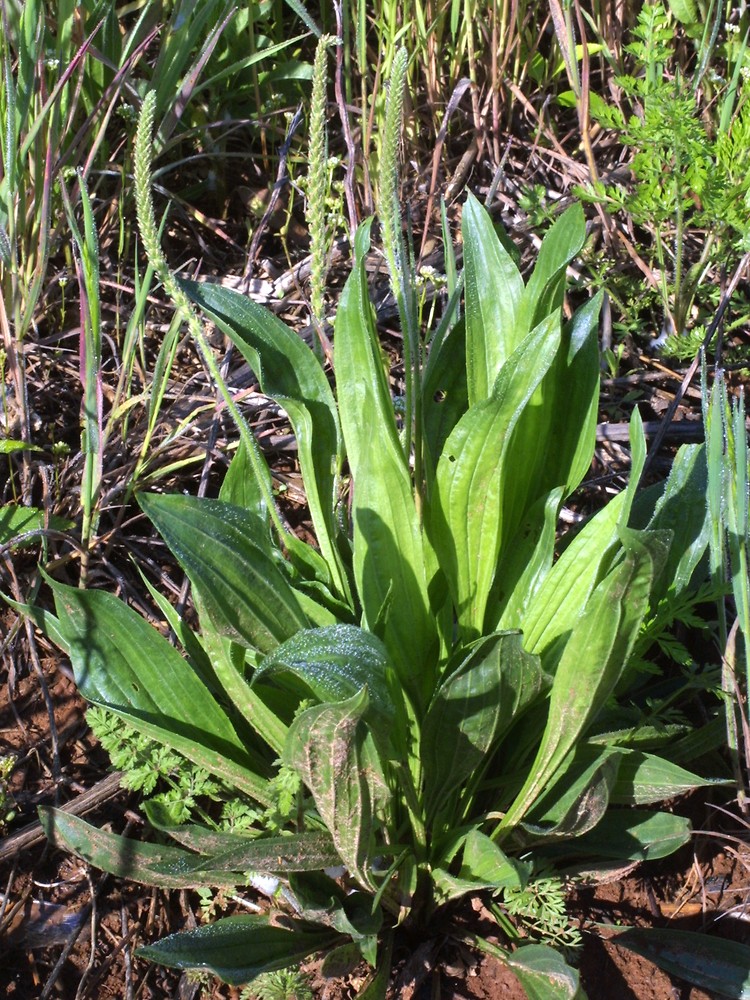
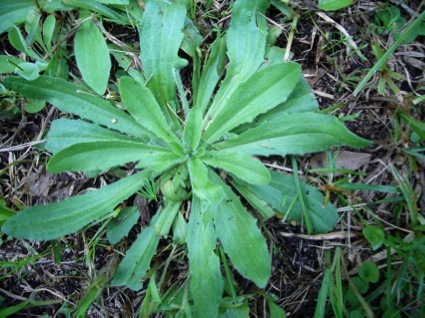
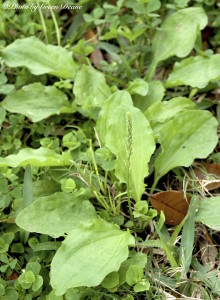
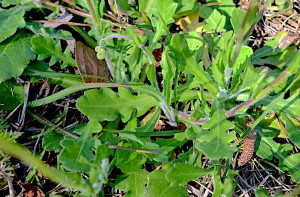
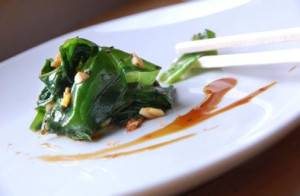

Just found out in the past 2 week’s my weed’s are edible….been looking for some recipe’s for plantain’s with no luck. Thank’s Deane, will soon be trying them.
There aren’t too many “recipes” for plantagos in that they are basically a green when young and can be cooked and uses like any green. A mustard green recipe would work.
Green Dean! I thank you so much!!! I wish I could take your classes in Florida! You have created such a wonderful site with so much information. This is a great way to get educated. Thank you so much.
Hi-great article! Do you know where I can purchase plantago virginica seeds? I’ve been looking without any luck and would love to plant some on my lawn. Thanks!
I know this is MANY years later, but I have seeds I can send you, if you’re still interested. Tons right now in my backyard.
Hello, was curious if you still have seeds you could send? I too have been looking with no luck and I got excited when it saw your comment.
Jemma, I have seeds of Plantago virginica.
I’m curious to know if the flower buds and shoots are edible. So far all the info I can find is on leaves and seeds, but nothing that addresses the flower buds and stems. In my area we have a great abundance of the narrow leaf variety. Can you offer a suggestion? Thanks!
The answer is in an article on my website about said.
Green Deane, nice article. I do find it interesting that there is very little mention of Plantago rugelii (Rugel’s plantain) in the wild food/medicine literature. This species is native to North America and is virtually indistinguishable from Plantago major (common plantain); technically speaking it has a slightly larger fruit with fewer, larger seeds than common plantain, but we are talking about tenths of mm (not things noticed by most people). My point with this is that Native Americans would have already been familiar with this plant. Though clearly increasing disturbance by colonists would have made both species more abundant (they are similar ecologically). Anyway, I’m always curious about this species, present before Europeans came to this land, and why that is rarely mentioned. Curious if you have come across anything on this. Best wishes.
I’ve tried plantain on wasp stings, and couldn’t feel any effect. Vitamin E, from a capsule, works instantly. I think weeds work best from the inside out.
Which plant did the recipe for plantain chips use? I’ve been using the Plantain lanceolata, but am not having good luck with the chips? Is the Plantain lanceolata edible?
Thanks,
Judy
Roasted Plantain Chips
Unlike the banana-related plantain chips of the supermarket, this wafer-thin chips are made with the leaves of the unrelated common plantain. They’re great, and it took Steve only 26 years of downplaying this plants food value to discover how to prepare it properly, using a method his wife uses for kale.
This is from your website. This is what I’ve been trying using the plantain lanceolata.
Thank you for the terrific photos and clarifications. Here in western Mass on a mountain top I have Plantago Major in my lawn adjacent to hay fields where Plantago Lanceolata also abounds. Dwarf Plantain and Plantago Virginica are quite common here as well. I am a bee keeper by profession, and the first thing I do when I arrive at a bee yard is look around for any form of plantain. It draws the formic acid out of an occasional sting for both me and my dog, and I’ve seen it cure poison ivy rash. I find that the trick is to chew it well, so that the cells of the leaf are well bruised and the poultice is quite wet. I apply a small poultice to the affected area, and I keep chewing and applying new poultices until the sting is resolved, which depends upon how long the stinger was imbedded. The same drawing action can be used for any kind of insect sting, as well as snake bites and traveling infections, as in a localized infection form a puncture wound that starts to travel down a finger or limb. I also make a tincture from fresh leaves to have on hand for treating winter coughs. In terms of a salad green, I chop the leaves into ribbons to minimize the fibrous effect without having to remove the individual fibers. I then message the greens well with olive oil and let them rest for 15-20 minutes before I dress them. I learned these tricks from my first herbalist teacher, Chris Marano. I’ll be happy to send some seeds to Stefka if you’ll forward my email, although I won’t post it here for broadcasting.
Thank you so much for the information you provide on this website. I moved to Central Florida from North Dakota nine months ago. Tonight it was recommended to me to try treating a dental abscess with poultice made of Plantago Major. I tried to recall if I’d seen any growing here. I did a google search for “Plantago Major” and Florida and found this post. Yes! I have P. Virginica growing in my lawn. You saved my day!
I would like to go this herb but I can not find seeds. Any suggestions?
Thank you!
It is highly seasonal. You will have to identify it in the spring and watch the plants for seeds.
I like your pictures here but on your YouTubes I could not tell for sure what mustard is (I’m familiar with the plant but your pictures are very poor) and the plantain as well, have not viewed more of your plants yet but sure wish your pictures were clearer!
I know what you mean. Those vieos were shot many years ago with a $149 flip camera
Hello,
I need some clarification. Are all plantain leaves purple at the stem? I have an abundance of plantain plants but I don’t see any purple.
No, just the opposite. I think only the P.rugelii is purple at the stem.
I wish I had read this earlier when I had an abundance of plantain growing near my garden. The recipe for Stuffed Plantain Leaf reminds me of the Stuffed Peppers and Rolled Cabbage my mother used to make. I will definitely give this a try next summer when the plantain is fresh.
Thanks for the recipes!
Plantago major is also an excellent treatment for fire ant bites. Just mash (or chew) a leaf and then apply the mess to the fire ant bites. The sting disappears instantly when the juice of the plantain touches the bite and best of all, there’s no sign of the bite afterwards. I have tried this with Plantago virginica but did not get the same results. It did absolutely nothing to relieve the fire ant sting.
Cuts and abrasions can be treated with the same mush of mashed plantain. It stops the bleeding and helps to heal the injury faster than the usual treatment with antibacterial ointment. I used it on a cut finger when I couldn’t find a proper bandage. The pain was eased somewhat but not completely but the cut itself healed quickly and with absolutely no infection. Great first aid remedy!
Now I have to try tea made from the leaves to see if it will help with my asthma. That is a new one for me!
During my teen years I suffered from several cyst on my ovaries, if you had them you know they can be painful!! As soon as the doctors recommended surgery my parents stormed out of there so fast. My parents are from Montenegro, where they used all of nature for healing and so they dragged me to the park and we started picking “weeds” lol I thought they’re were crazy. They brought them home washed, minced & crushed the leaves, put in raw honey and they told me to take a spoonful EVERY morning till I finished. Within a few months we went back for an ultrasound and ALL cyst were gone
Glad to know the name of this plant in English and glad for my parents!
I have to say the question about Plantago rugelii triggered a memory. That memory was that dandelions, not Plantain were called white man’s foot, while honeybees were white man’s flies. I remember an old Indian mentioning this at a powwow. Might be the various tribes had the same names for different plants (who would do that).
Yes this is something I also learned and hears from an elder. 🙂
And everyone let’s remember to offer tobacco before taking anything please. And you don’t need to take every plant you see.
One more thing. Per Archeology today, plantain is used, by archeologists to determine if a field was used for agriculture in ancient times in North America. If they find the seeds or pollen of “little foot”, which invades fields shortly after they have been cleared for growing crops, the area was used for agriculture. So, again, I question the white man’s foot label.
The “White Man’s Foot” was their name for Plantago major from Europe.
plantago patAgonies (wooly plantain)–are the uses the same or different?
I was told that a poultice is good for drawing out both infection and cysts or tumors…
Thanks for the information. This plant is wonderful. It heals gastritis and some other stomach problems. I am from Cuba and my ancestors use this plant for lots of reasons: Gastritis, colds, liver disease, and the bladder.
There is a famous recipe to heal the gastritis with the juice of the leaves:
Have two hands of leaves well washed with two TBS of boiled water. Crush the leaves in a juice grinder or a traditional wheat juicer (much better) and add 5 drops of organic lemon.
Drink the preparation first thing in the morning and wait for 3o min before eating your breakfast for 3 months. Your gastritis will be gone.
Ohh I forgot to mention that the one we use is plantago major. You can find this plant everywhere. God is good
Hallo, can anyone tell me if I can dry the leaves and still have them preserve their medicinal quality. We have just bought a plot of land to build a house on. The whole field is full of very healthy looking plantago major.
By the way, i do know that you can dry the leaves a bit on a kitchen counter, then put them in a bottle and fill this with glycerine. If you put this lotion when it has been about a week in the bottle and has takenon the plant’s gift you can apply it to your forehead, arms or bare legs you will generally not be bothered by biting midges. It also deters fleas from biting and cools a flea bite if you do get bitten.
Here in the PacNo we have several varieties, but in my area out east we mostly only have the narrowleaf plantain. I see it both outside my front door and 30 miles away along the riverbanks. I do sometimes see the broadleaf– yes, in places where people have previously tread– on hiking trails or parking areas and only near the mountains or waterways.
For topical use I find the narrowleaf plaintain does little for bug bites/stings or wounds. However, both the deer and myself like to nibble the flower heads raw, they taste slightly sweet and are usually plentiful. As long as they still have the tiny petals on them, they’re good to go, but once the white petals have fallen off, they become bitter and are best used for gathering the seeds. The slender but numerous leaves vary from tasteless to bitter raw but cooked are just fine. The somewhat bitter seeds are small and a pain to winnow but cooked taste mild and can be used as any other seeds, such as flour extenders, soup/salad add-ins, etc.
As far as the previous poster saying to offer tobacco whenever gathering, I disagree mainly because tobacco contains toxic nicotinoids, which are commonly used as pesticides and are one of the chemicals blamed for bee colony collapse. I kind of think Ma Nature isn’t going to be happy if you come into her home, spread some poisonous stuff around and then yank up a bunch of her plants.
Just have good intentions when you go out into nature.
Love to all!
Nice description of narrowleaf and its properties. Two things about your tobacco comments, if I may. Neonics as pesticides are not going to be an issue for other plants when commercial tobacco leaves are sprinkled around…should investigate the chemistry and production of neonics there to understand better. Perhaps some of the other bazillion additives in commercial tobacco products could be harmful, but unlikely in the tiny “sprinkle” offering amounts alluded to in that suggestion…plus they are left exposed to the elements. Also, “tobacco” to native peoples, while used the same way mostly, was not at all like our modern commercial tobacco leaves/products. There’s a very important distinction there, depending on who you’re asking, I suppose. The native tradition of offering thanks (actively) to plants and animals was not practiced by all native peoples here, but it is a lovely – and I think an important – aspect of life-taking-life-to-live that reminds us of our very intimate connection with this earth and all of its inhabitants. Many may see offerings as trite, but the spirit in the act is one from within, from a loving heart – or should be.
I disagree. “Sprinkle” was nowhere alluded to in that suggestion, and even if, considering that ‘bazillion’ additives are possible, why get into it at all? If all foragers start to ‘sprinkle’ the drops will add up to said bazillion. Moreover, are we still babies, hundreds of years later, to need ritual sacrifices to remind us that the earth is not to be unnecessarily plundered? I think it is an easy enough thing to bear in mind always without having to resort to a solution that will create a worse problem that the picking of a few plants in a zone of plenty.
I think Lightfeather makes a good point in saying, ‘You don’t need to take every plant you see’ – obviously meaning, take only what you need.
But I very much agree with you on the ‘offering’ of tobacco. It’s a meaningless ritual, and as you say, might do more harm than good. It will be an alien addition to a plant site, possibly not conducive to its soil chemistry and the prevalent plant chemistry, and if commercial, as it is likely to be in these times, god knows how many artificial, chemical additives will be involved.
Your description of the edibility of flower of plantain is also appreciated. I have tons growling in my area.
If you make an offering of commercially grown tobacco, doesn’t that defeat the purpose?
Many Nicotiana sp are easy to grow. Though so far coyote tobacco has not germinated.
I just started trying this out. I was at work and came across a North American Wildlife guide and saw this (Plantago Major) that is edible, and realized my yard seems to be a garden for this stuff. So I went a week without mowing, filled a grocery bag picking them (large and small leaves). Rinsed them off really good, then made a vinaigrette, add some fine chopped white onion and dandelion greens (from the yard as well). The large leaves are extremely bitter in the raw state, as in they seem pull the moisture from your mouth almost when chewing them up. I find to let them sit combined with the vinaigrette for at least a day or two to tame the bitterness. Add salt and white pepper. My question, will the vinegar remove any of the vitamins/health benefits or will it complement it? Anyways I have an abundance of free fresh greens now 🙂
As far as I know the vinegar does not reduce nutriments and might even increase some.
Hi! I’m trying to identify a Plantain I have growing wild in my yard. At first I thought it might be plantago lanceolata but now it looks more like plantago virginica. However, my plantago has purple at the base. I don’t think I can attach a photo so I will describe it as best as I can. Narrow long leaves that are hairy. Ribs on the back of the leaves. Strings inside leaves, when broken. Purple color at the base of the leaves. Long stalks of seeds. Seeds cover the length of the stalks.
Dean,
I found a plant that looks very similar to plantain (the broad leaf variety), but is a vibrant purple underneath. It tastes SWEET. NOT AT ALL LIKE PLANTAIN, especially at the age it would have to be at this size. It’s like a large full grown leaf. Wish I could send you a pick. Coming up as single leaves through the dead leaf cover in very moist soil. It’s the end of January and we’ve been having freaking temps at night here in VA.
At some stages plantago has fair amount of sugars in the leaf. When I freeze the leaves, rupturing the cells, can taste sweetness.
Im still trying to find rattlesnake root on this site. It grows like crazy in central AL, everyone wants me to deweed their gardens from it, but it is soooo tasty. I tried to tell them how good they have it to have a veggie crop growing like wild, but they looked at me like I was insane.
Sea plantain, aka goose tongue plantain? I planted seeds in pots last year. Solid taproots, they came back strong this spring. Clearly not obligate salty soil plants.
Does anyone have plantains around Williston Florida I would love to have some
I would like to have some white man’s feet leaves and seeds. Does it grow in the Southwest. I live in Arizona. Thanks